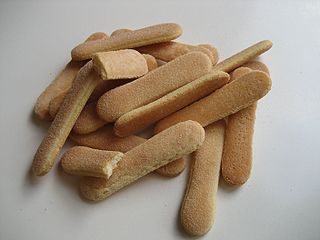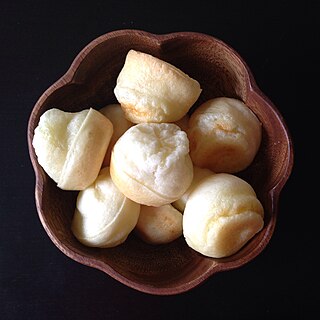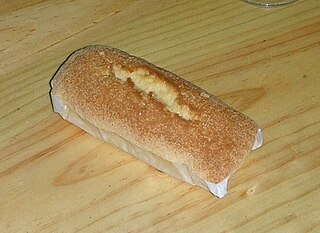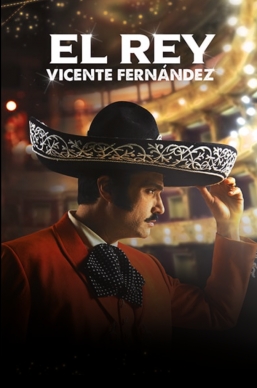
An empanada is a type of baked or fried turnover consisting of pastry and filling, common in Spain, other Southern European countries, Latin American countries, and the Philippines. The name comes from the Spanish empanar, and translates as 'breaded', that is, wrapped or coated in bread. They are made by folding dough over a filling, which may consist of meat, cheese, tomato, corn, or other ingredients, and then cooking the resulting turnover, either by baking or frying.

An alfajor or alajú is a traditional confection typically made of flour, honey, and nuts. It is found in Argentina, Bolivia, Paraguay, the Philippines, Southern Brazil, Southern France, Spain, Uruguay, Peru, Ecuador, Colombia, Venezuela, El Salvador and Chile. The archetypal alfajor entered Iberia during the period of al-Andalus. It is produced in the form of a small cylinder and is sold either individually or in boxes containing several pieces.

Ladyfingers, or in British English sponge fingers, are low-density, dry, egg-based, sweet sponge cake biscuits roughly shaped like large fingers. They are a principal ingredient in many dessert recipes, such as trifles and charlottes, and are also used as fruit or chocolate gateau linings, and for the sponge element of tiramisu. They are typically soaked in a sugar syrup or liqueur, or in coffee or espresso for tiramisu. Plain ladyfingers are commonly given to infants, being soft enough for teething mouths, but easy to grasp and firm enough not to fall apart.

Arepa is a type of flatbread made of ground maize dough stuffed with a filling, eaten in northern parts of South America since pre-Columbian times, and notable primarily in the cuisine of Colombia and Venezuela, but also present in Bolivia, Ecuador, and Central America.

Cachapa is a traditional dish made from maize flour from Venezuela. Like arepas, they are popular at roadside stands. They can be made like pancakes of fresh corn dough, or wrapped in dry corn leaves and boiled. The most common varieties are made with fresh ground corn mixed into a thick batter and cooked on a budare, like pancakes; the cachapa is slightly thicker and lumpier because of the pieces from corn kernels.

Salvadoran cuisine is a style of cooking derived from the nation of El Salvador. The indigenous foods consist of a mix of Amerindian cuisine from groups such as the Lenca, Pipil, Maya Poqomam, Maya Chʼortiʼ, Alaguilac and Cacaopera peoples. Many of the dishes are made with maize (corn). There is also heavy use of pork and seafood. European ingredients were incorporated after the Spanish conquest.

Gofio is a sort of Canarian flour made from roasted grains or other starchy plants, some varieties containing a little added salt. Gofio has been an important ingredient in Canarian cooking for some time, and Canarian emigrants have spread its use to the Caribbean and the Western Sahara. There are various ways to use it, such as kneading, dissolving in soup, and baking. It can also be used as a thickener. It is also found in Argentina, Uruguay, and Chile, where it is known as harina tostada and is employed in a wide variety of recipes. The gofio commercially available in the Canary Islands is always finely ground, like ordinary flour, despite the definition given in the Spanish Dictionary of the Royal Academy.

Pão de queijo or Brazilian cheese balls is a small, baked cheese roll or cheese ball, a popular snack and breakfast food in Brazil. It is a traditional Brazilian recipe, originating in the state of Minas Gerais.

Biscocho, also spelled biskotso, refers to various types of Filipino twice-baked breads, usually coated with butter and sugar, or garlic in some cases. Biscocho is most strongly associated with the versions from the province of Iloilo, although it actually exists nationwide in various forms. It is also known as biscocho duro, machacao, or matsakaw. It is also historically known as pan de caña.

Colombian cuisine is a culinary tradition of the six main regions within Colombia. Colombian cuisine varies regionally and is influenced by Indigenous Colombian, Spanish, and African cuisines, with a slight Arab influence in some regions.

Papas rellenas are the most popular type of croquettes in Latin American regions such as Peru, Ecuador, Bolivia, Mexico, Chile, Colombia, and the Caribbean.

Tolima is one of the 32 departments of Colombia, located in the Andean region, in the center-west of the country. It is bordered on the north and the west by the department of Caldas; on the east by the department of Cundinamarca; on the south by the department of Huila, and on the west by the departments of Cauca, Valle del Cauca, Quindío and Risaralda. Tolima has a surface area of 23,562 km2, and its capital is Ibagué. The department of Tolima was created in 1861 from a part of what was previously Cundinamarca.

Valledupar Fútbol Club was a professional Colombian football team based in Valledupar, that last played in the Categoría Primera B, the second tier of Colombian professional football. They played their home games at the Estadio Armando Maestre Pavajeau.

Mantecadas are spongy pastries originating in Spain. Perhaps the best known mantecadas are from Northwestern Spain, being a traditional product of the city of Astorga, province of León, as well as the nearby Maragateria comarca. They taste very much like pound cake.

Pan dulce, literally meaning "sweet bread", is the general name for a variety of Mexican pastries. They are inexpensive treats and are consumed at breakfast, merienda, or dinner. The pastries originated in Mexico following the introduction of wheat during the Spanish conquest of the Americas and developed into many varieties thanks to French influences in the 19th century.

Uraró, also known as araró or arrowroot cookies, are Filipino cookies made from arrowroot flour. They have a dry and powdery texture and are usually flower-shaped. They originate from the Tagalog people of southern Luzon, particularly in the provinces of Laguna, Quezon, and Marinduque.
The 2021 Categoría Primera A season was the 74th season of the Categoría Primera A, Colombia's top-flight football league. The season began on 16 January and ended on 22 December 2021. América de Cali entered the season as defending champions having won back-to-back titles in the 2019 Finalización and 2020 tournaments.

Sorrentinos are a type of Argentine ravioli, but larger, more circular and originally wraped without fluted edge. The dough is made with flour and eggs, and the filling of the original recipe consists of York ham and mozzarella.

El Rey, Vicente Fernández is a Mexican biographical drama produced by Colombian network Caracol TV. The series aired first in Colombia on Caracol TV from 3 August 2022 to 16 September 2022. The series became available for streaming outside Colombia on Netflix on 14 September 2022. On Netflix, the series has a total of 36 episodes.



















